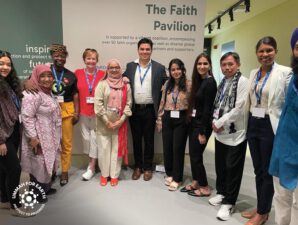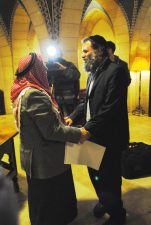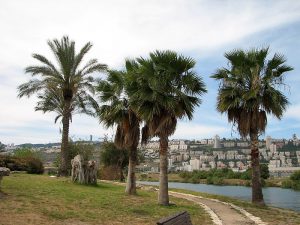 Got strong jaws? Noam Edry’s Seeds of Bliss project promotes international friendship by sunflower seed.
Got strong jaws? Noam Edry’s Seeds of Bliss project promotes international friendship by sunflower seed.
It’s a custom observed by folks everywhere in the Middle East. Neighbors and family get together, sharing a platter of the plump, salty, black seeds and sipping cups of strong coffee. (And if you’re curious to taste the real thing, try our coffee recipe here.) Maybe taking a leisurely pull at the narghila pipe, although the narghila has been proven stronger than cigarettes. A relaxed meeting between neighbors – or a friendly, apolitical way for Jews and Arabs to meet? Sounds crazy, but it’s working. In artist Noam Edry’s project, Jews and Arabs, Jordanians and Israelis travel to each others’ cities, sit down at cafes, and chew sunflower seeds together. In between chewing and spitting out the seeds, there’s plenty of chat and getting to know each other, at a grassroots level, if you will.
Sounds crazy, but it’s working. In artist Noam Edry’s project, Jews and Arabs, Jordanians and Israelis travel to each others’ cities, sit down at cafes, and chew sunflower seeds together. In between chewing and spitting out the seeds, there’s plenty of chat and getting to know each other, at a grassroots level, if you will.
The ostensible goal of the project is to make 10 tons of chewed and discarded hulls, which will then be shipped to London as part of an art exhibit. But the real goal is to open doors of friendship.
British-Israeli artist Noam Edry was inspired by Chinese artist Ai Weiwei ‘s 10 million sunflower-seed replicas on the floor of London’s Tate Museum. Weiwei’s installation represented political and social issues of the Chinese, but Edry brought the idea several steps closer to home. Since Arabs and Jews enjoy chewing the seeds, the leap to inviting Arabs and Jews to sit down together and chew for peace took only a certain out-of-the-box logic.
The “Big Chew” project began in August 2012, when chewers from Kibbutz Ramat Yohanan met with seed-chompers from neighboring Arab/Beduin villages Khawaled, Ibtin, Shfaram and Zarzir.
These events last up to five days, during which everyone in the vicinity is invited to join the core champions. At the end of each meeting, all the hulls are swept up and stored in plastic bags against the day that they’ll reappear as art – and proof that friendship can sprout even in the conflicted soil of the Middle East.
“The goal is to have a meaningful encounter and to develop a real friendship,”says Edry.
In September, a team of eight Jewish and Arab Israeli chewers traveled to Aqaba, spending five days chewing seeds with local folk at a café. Edry overcame bureaucratic objections (and maybe bureaucratic disbelief) to bring 10 Jordanians from Aqaba to Eilat in order to to sit down with sunflower lovers from across the Red Sea. This month’s seed-chewing event took place at Haifa’s Art and Street Culture Festival, where ten residents of Nablus joined Jews in exercising their jaws cracking seeds and chatting. The Governorate of Nablus will sponsor a reciprocal event there.
“At first we were afraid of coming to Haifa and we thought that people would hate us. Instead we were greeted by loving people, who made us feel so welcome and at home,” said one of Nablus participants.
Seed-lovers from Jenin and Afula are scheduled for November’s “Big Chew.”
Edry seems to be one of those people who doesn’t allow anything to get in the way. Facing down incredulity, discouragement, heavy-handed flirtation, the language barrier and the price of the project, she smiles and plows ahead. Each ton of sunflower seeds costs NIS 6000; close to US$1.1572. There are sponsors: Haifa Museum of Art and Artis Contemporary, a nonprofit organization that promotes contemporary Israeli artists. Seeds are donated by the local companies Zarubi Seed, Hazera, Migdan, kibbutzim and private donors. But it seems that Edry’s invincible drive is the project’s most valuable asset.
Who are the chewers? Anyone, of any age, who can chew and spit out the seeds with expert speed. Edry actually brings bags of seeds for “auditions” when recruiting new participants. It’s amazing and encouraging how seriously folks take the whole fantastic project, grasping what the mountain of chewed-up hulls is meant to represent right away.
And what will become of the hulls? They will be piled up into a hill along with any street litter swept up with them, as an art installation. A movie documenting every event and encounter will be projected next to it.
Edry calculates that one person can chew around 200 grams a day.
“Imagine how many are needed for 10 tons – thousands of people,” she says enthusiastically.
[youtube http://www.youtube.com/watch?v=4GFt3_cJDEo?rel=0]
More on peace efforts and interfaith projects happening in the Middle East:
- Can Shared Water Be The Key To Peace?
- Interfaith Eco-Conference Reveals Need to Educate Religious Leaders




There’s nothing “Green” about this. Not only are sunflowers not indigenous to the region, but they require alot of water to produce those seeds. And right now, Arabs need Israeli artists to help end the expansion of settlements and the war, not create bourgeoisie art projects that are bad for the environment, and probably bad for your health. It’s not a war with Gaza, it’s a WAR ON GAZA.
Agricultural production could be the key to an Israeli-Palestinian peace. An operational airport in Gaza, could be used by Israeli farmers in the Negev to fly out fresh fruit and flowers overnight to markets in Europe. Gaza could be receiving service fees and taxes from such services. Gaza schools are now offering Hebrew, use it as the language to communicate to future customers. The potential is as great, as the germinating seed.